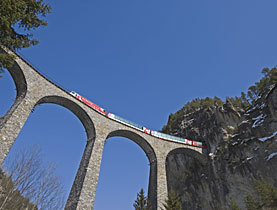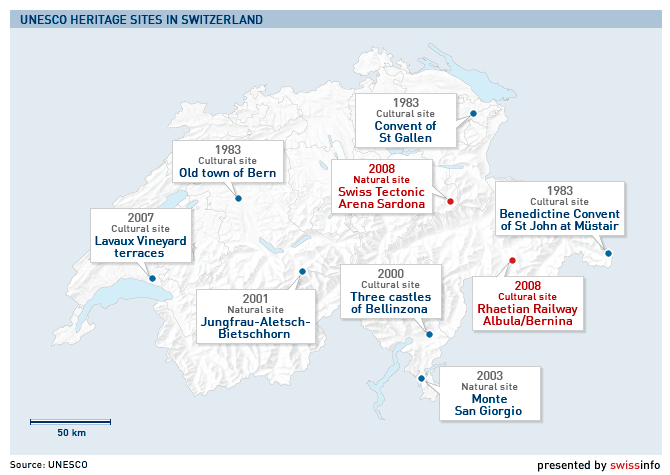
Unesco recognises value of two Swiss sites

A rock formation and scenic mountain railway line are the latest Swiss sites to win World Heritage recognition from United Nations culture organisation, Unesco.
The geological attraction and railway were deemed of “outstanding universal value” on Monday. But the listing is also a wake up call to the Swiss to step up efforts to preserve and market their nine sites.
The Swiss Tectonic Arena Sardona or Glarus Overthrust, is a formation in central Switzerland revealing to the naked eye how the Alps were formed.
A clearly visible “magic line” separates the older, darker rock on top and the younger, lighter rock below.
The Rhaetian Railway in the Albula/Bernina Cultural Landscape is an engineering marvel of stone viaducts and loops crossing two alpine passes and connecting Switzerland with Italy.
The Albula and Bernina lines cover a total of 122 km. The Albula crosses 52 bridges and features 13 tunnels and galleries, while the Bernina run crosses 144 bridges, including the circular Brusio viaduct, and has 42 tunnels and galleries. The high point of the Bernina line is at 2,253 m.
The decision by Unesco’s World Heritage Committee to inscribe the two sites at its meeting in Quebec City on Monday obliges the Swiss to safeguard them for future generations.
But Switzerland could be considered a victim of its own success. Up until eight years ago, only three sites had World Heritage Status and these – Bern’s old town, and the convents of St John at Müstair and St Gallen – are in different corners of the country.
Since 2000, there has been a listing almost every year, and one more is expected in 2009, but Switzerland has yet to implement a coordinated management plan or promotion scheme.
Preserve and promote
Beat Ruppen, member of Switzerland’s Unesco Commission and director of the World Heritage Site, Jungfrau-Aletsch-Bietschhorn, says efforts are being made to set up a network to make information on all the locations available.
Ruppen sees the main challenge in sensitising Switzerland’s well-developed tourism industry to the need to preserve as well as promote.
“It must become more responsible as far as sustainability is concerned and this process must be inclusive, involving all parties,” he told swissinfo.
He said access to and usage of the Jungfrau-Aletsch-Bietschhorn site still had to be defined, and called for the site’s universal values to be integrated into the tourist offers to raise awareness among visitors.
European football’s governing body, Uefa, was recently criticised by Switzerland’s Unesco Commission for “misusing” the label to promote fan zones in Bern during the Euro 2008 championships without mentioning the heritage values or contributing to the site’s preservation.
Valuable brand
For Switzerland’s national tourist office, the label is first and foremost a very “valuable brand”.
“It’s very good for the image of a small country like Switzerland to have so many inscribed sites. These places are authentic and have developed organically so they can be marketed as such,” Roger Waber of Switzerland Tourism told swissinfo.
There will be a first meeting of the tourist authorities of the nine sites later this month in an effort to coordinate promotion.
A good example of how one site has succeeded in using the Unesco status to preserve and promote itself is the Benedictine Convent of St John at Müstair in southeastern Switzerland.
“We use the label in our presentations since it is international recognition for the site, and is therefore expected to be preserved for humanity,” Elke Larcher of the convent foundation said.
Invaluable
The Convent of St John is celebrating its 25th anniversary this year as a World Heritage Site and the label has proven to be invaluable for the complex housing 1,200-year-old figurative murals as well as Romanesque frescoes and stuccoes.
“It reminds the Swiss government that it has a commitment to the world community to preserve the site and support further research,” Larcher said in a recent article she co-authored.
“Both visitor numbers to our museum and reports in the media are steadily increasing,” she told swissinfo. “We do not know if the increases are a result of the Unesco label, but we are sure it has had a positive effect.”
Larcher added that the murals and other ancient works of art have not suffered from the additional tourists drawn to the site. Controlled monitoring of the humidity ensures the murals are not damaged, and no acts of vandalism have been reported.
“The recognition by Unesco makes local people more proud of where they live and should make tourism developers aware of the unique values of the sites and what that means for future generations,” Ruppen said.
swissinfo, Dale Bechtel
To date, Unesco’s 1972 Convention on the Protection of the World Cultural and Natural Heritage protects more than 850 properties of “outstanding universal value,” including more than 660 cultural, 165 natural and 25 mixed properties in 141 states.
Switzerland’s current sites are:
Benedictine Convent of St John at Müstair (1983)
Convent of St Gallen (1983)
Old town of Bern (1983)
Three castles, defensive wall and ramparts of Bellinzona (2000)
Jungfrau-Aletsch-Bietschhorn (2001)
Monte San Giorgio (2003)
Lavaux Vineyard terraces (2007)
Swiss Tectonic Arena Sardona (2008)
Rhaetian Railway in the Albula/Bernina Cultural Landscape (2008)
A decision by Unesco is expected to be taken next year on the watchmaking urban area of La Chaux-de-Fonds and Le Locle.


In compliance with the JTI standards
More: SWI swissinfo.ch certified by the Journalism Trust Initiative

















![The four-metre-long painting "Sonntag der Bergbauern" [Sunday of the Mountain Farmers, 1923-24/26] had to be removed by a crane from the German Chancellery in Berlin for the exhibition in Bern.](https://www.swissinfo.ch/content/wp-content/uploads/sites/13/2025/12/01_Pressebild_KirchnerxKirchner.jpg?ver=a45b19f3)












You can find an overview of ongoing debates with our journalists here . Please join us!
If you want to start a conversation about a topic raised in this article or want to report factual errors, email us at english@swissinfo.ch.